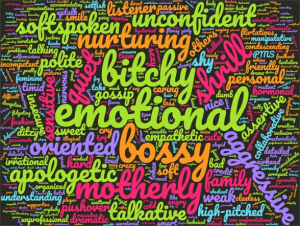
Word cloud showing most commonly occurring words and phrases elicited via focus groups. “Perceptions of stereotypes applied to women who publicly communicate their STEM work” by McKinnon and O’Connell
The lack of equal opportunity in the field of STEM (science, technology, engineering and math) still exists. Though perhaps improving, sexist tropes and stereotypes continue to plague women in the field. Women in STEM are still often overlooked for professional development opportunities, promotions and research positions. However, let me be clear: this issue is not exclusive to the STEM field; such biases have been commonplace since women were allowed to join the workforce – of course, on a conditional basis. Traditionally women had to be unmarried, childless and willing to work long hours for wages significantly lower than their male counterparts.
Merryn McKinnon and Christine O’Connell investigated the perceptions of stereotypes that prevail on female STEM professionals who speak publicly about their work. Their study, based on workshops with over 300 participants, found that women in STEM who spoke openly about their work were more likely to be seen as “bitchy,” “bossy” or “emotional.” It seems women continue to be penalized on a two-fold scale. First, if they conform to the stereotype of being “warm” or “empathetic,” they may be perceived as having a lack of competence, confidence and assertiveness required for the competitive field of STEM jobs, and simultaneously risk judgment by other women for further perpetuating female stereotypes. Second, if they do not conform to such gender biases, their professional advancement could suffer too; nobody likes an “aggressive” woman in the workplace.
Participants in Drs. McKinnon and O’Connell’s study shared stories of how they modified their behaviour while in their professional environments to combat stereotypes. For example, when discussing stereotypes related to appearance, one participant admitted that she intentionally did not wear heavy make-up, wore her hair up and wore glasses when she gave presentations to increase her credibility among her peers. Another participant mentioned she rarely wore skirts at conferences or public speaking engagements to avoid the male gaze while presenting on stage. Sadly, stereotypes were often applied to these women by other women.
Increasingly, research has shown that when women in STEM make efforts to counteract biases they are met with increased levels of hostility from their female colleagues. Such underlying implicit biases demonstrate a common phenomenon in today’s professional workplace. Members of marginalized groups will often punish or ostracize individuals in the same group for publicly demonstrating negative stereotypes that could unfairly disadvantage their community. This form of internalized misogyny and sexism is not frequently discussed amongst colleagues, but is well documented in STEM fields and sadly reinforces gender inequality.
To counteract negative judgments, women in STEM are encouraged to act as role models. Drs. McKinnon and O’Connell ask the following questions: Are women being put at risk when we encourage them to be public role models? And by doing so, aren’t they being further exposed to the negative perceptions of others? Furthermore, it makes me wonder, why is the onus on women to counteract existing stereotypes?
You are probably thinking, today is International Day of Women and Girls in Science, why the heck is she talking about all this non-celebratory stuff today? In recognition of this important day, it’s necessary to highlight what it’s like to be a woman in STEM and, although a significant amount of progress has been made, remind people that there is still a lot of work to do.
Employers and institutions must recognize that when a working environment is perceived as unfriendly towards women, this negative perception often has a direct effect on one’s performance at work. Therefore, as Drs. McKinnon and O’Connell explain, negative stereotypes about women not only affect women, but the organizations they are employed by.
If a woman communicates her work publicly, and she is seen as “bossy” or “undeserving,” then perhaps we need to change our approach. I’m not suggesting that women in STEM avoid speaking publicly about their work or accomplishments, but perhaps we need to place more of the responsibility back on men, and those in positions of power and privilege, to challenge the narrative. Moving beyond bystandership, one should strive towards allyship, which doesn’t merely involve promoting women into positions of power, or offering them research positions, but rather, learning to effectively challenge gender bias when you see it.
Tannen Horber
Latest posts by Tannen Horber (see all)
- The value of mentorship in Canada’s biotech industry - February 23, 2023
- Women in STEM: A reality check - February 11, 2022
- What does Jane Krakowski have to do with stem cells? - October 21, 2021






Comments